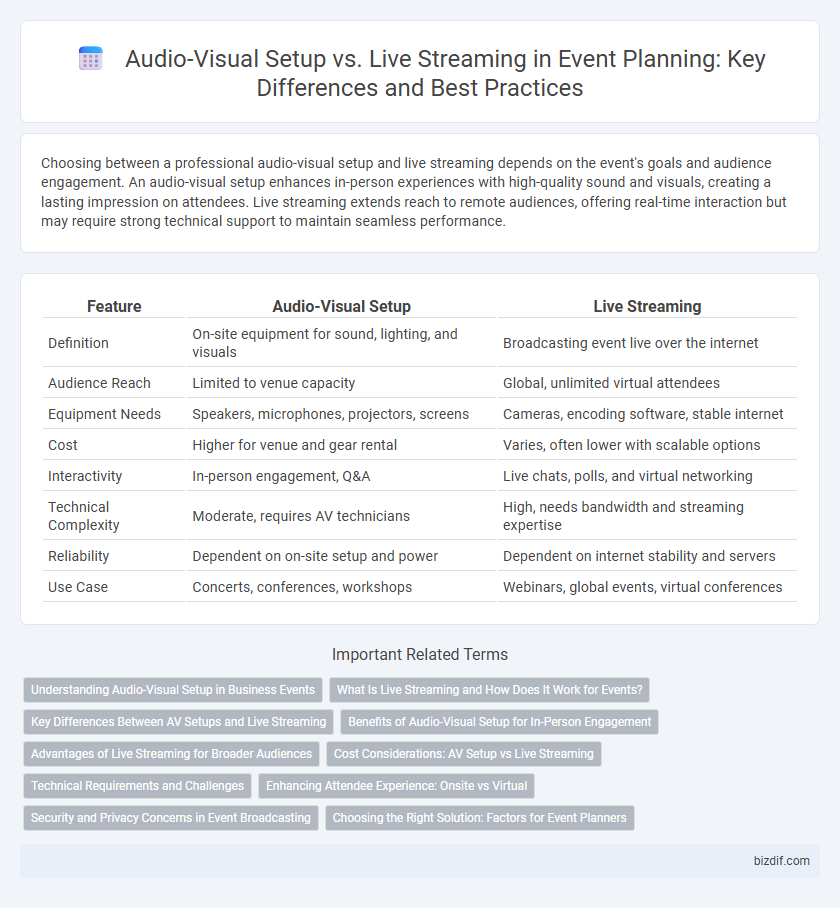Choosing between a professional audio-visual setup and live streaming depends on the event's goals and audience engagement. An audio-visual setup enhances in-person experiences with high-quality sound and visuals, creating a lasting impression on attendees. Live streaming extends reach to remote audiences, offering real-time interaction but may require strong technical support to maintain seamless performance.
Table of Comparison
| Feature | Audio-Visual Setup | Live Streaming |
|---|---|---|
| Definition | On-site equipment for sound, lighting, and visuals | Broadcasting event live over the internet |
| Audience Reach | Limited to venue capacity | Global, unlimited virtual attendees |
| Equipment Needs | Speakers, microphones, projectors, screens | Cameras, encoding software, stable internet |
| Cost | Higher for venue and gear rental | Varies, often lower with scalable options |
| Interactivity | In-person engagement, Q&A | Live chats, polls, and virtual networking |
| Technical Complexity | Moderate, requires AV technicians | High, needs bandwidth and streaming expertise |
| Reliability | Dependent on on-site setup and power | Dependent on internet stability and servers |
| Use Case | Concerts, conferences, workshops | Webinars, global events, virtual conferences |
Understanding Audio-Visual Setup in Business Events
Audio-visual setup in business events involves the strategic integration of equipment such as microphones, speakers, projectors, and video walls to enhance communication and audience engagement. Proper AV configuration ensures clear sound distribution and high-quality visual content, crucial for presentations and interactive sessions. Mastery of AV setup technology directly impacts the professionalism and effectiveness of business events, distinguishing them from purely live streaming solutions focused on remote broadcasting.
What Is Live Streaming and How Does It Work for Events?
Live streaming for events involves capturing real-time video and audio through cameras and microphones, encoding the content into a digital format, and broadcasting it over the internet to remote viewers via platforms like YouTube, Vimeo, or specialized event streaming services. This process requires a stable broadband connection, professional audio-visual equipment, and streaming software or hardware to ensure high-quality transmission and audience engagement. Unlike traditional audio-visual setups that cater to on-site attendees, live streaming extends the event's reach globally, enabling virtual participation and instant interaction through chat and Q&A features.
Key Differences Between AV Setups and Live Streaming
Audio-visual (AV) setups primarily involve the integration of equipment like microphones, projectors, speakers, and lighting to enhance in-person event experiences through clear sound and vivid visuals. Live streaming, on the other hand, extends the event's reach by broadcasting real-time video and audio content over the internet, requiring encoding software, high-speed internet, and streaming platforms such as YouTube or Zoom. Key differences include the targeted audience--on-site participants for AV setups versus remote viewers for live streaming--and technical requirements focusing on local hardware versus network bandwidth and digital distribution.
Benefits of Audio-Visual Setup for In-Person Engagement
An advanced audio-visual setup enhances in-person event engagement by delivering crystal-clear sound and vibrant visuals that captivate the audience and maintain their attention. High-quality AV equipment supports interactive presentations and seamless communication among attendees, fostering a more immersive and memorable experience. Reliable audio and visual elements minimize technical disruptions, ensuring smooth event flow and reinforcing a professional atmosphere.
Advantages of Live Streaming for Broader Audiences
Live streaming enables event planners to reach a significantly larger and geographically diverse audience, breaking the limitations of physical venue capacity. It offers real-time interaction and engagement through chat and Q&A features, increasing audience participation and satisfaction. The integration of analytics and data tracking in live streams provides valuable insights into viewer behavior, helping optimize future events for broader outreach.
Cost Considerations: AV Setup vs Live Streaming
Audio-visual setup costs often include equipment rental, technical staff, and on-site logistics, making it a significant upfront investment. Live streaming can reduce expenses by eliminating venue-specific AV requirements and enabling remote production, but may incur recurring platform fees and bandwidth costs. Evaluating the total cost of ownership requires comparing fixed AV setup expenses with the variable costs associated with streaming platforms and internet infrastructure.
Technical Requirements and Challenges
Audio-visual setup requires precise calibration of equipment such as microphones, projectors, and sound systems to ensure optimal sound and video quality in the venue, often demanding skilled technicians and robust hardware. Live streaming introduces challenges including stable high-bandwidth internet, real-time encoding, and latency management to deliver uninterrupted content to remote audiences. Both setups must address synchronization issues and backup power solutions to prevent technical failures during events.
Enhancing Attendee Experience: Onsite vs Virtual
Audio-visual setup enhances onsite attendee experience by delivering high-quality sound, vivid visuals, and seamless presentations that engage audiences physically present. Live streaming expands reach to virtual attendees, providing real-time access to event content with interactive features like chat and polls that foster engagement despite remote participation. Combining robust AV technology with live streaming tools ensures a cohesive experience, maximizing interaction and satisfaction across both onsite and virtual audiences.
Security and Privacy Concerns in Event Broadcasting
Audio-visual setup in event planning offers controlled, on-site management of equipment, reducing risks of unauthorized access and data breaches compared to live streaming. Live streaming introduces higher security vulnerabilities due to potential interception, hacking, and unauthorized distribution of sensitive event content over the internet. Implementing end-to-end encryption and secure access protocols is critical to safeguarding privacy and maintaining event broadcast integrity.
Choosing the Right Solution: Factors for Event Planners
Event planners must evaluate venue capabilities, audience size, and budget when choosing between audio-visual setup and live streaming for events. Audio-visual setups provide enhanced on-site engagement and control over sound and visuals, ideal for intimate or hybrid gatherings. Live streaming extends event reach globally, requiring robust internet infrastructure and technical support to ensure seamless virtual participation.
Audio-visual setup vs live streaming Infographic

 bizdif.com
bizdif.com